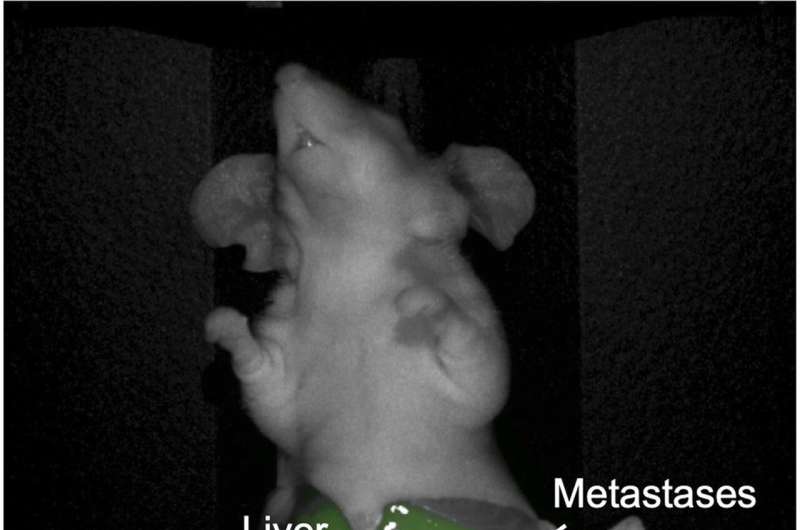Colon cancer PDOX model with regional metastases, implanted on the cecum with patient-derived primary colon tumor sample Lung 4. The mouse was administered 50 mcg 6G5j-IR800CW and imaged 48 hours after administration. Fluorescence of the bladder is due to excretion of IR800CW dye in urine. Credit: Michael Bouvet, email: mbouvet@ucsd.edu
In this Oncotarget study, the authors test a novel anti-CEACAM antibody conjugated to a fluorescent dye for detection of multiple CEACAM antigens to enhance visualization of colorectal PDOX tumors and metastases in murine models.
The research team's aim was to investigate mAb 6G5j binding characteristics and to validate fluorescence targeting of colorectal tumors and metastases in patient derived orthotopic xenograft models with fluorescently labeled 6G5j.
Nude mice received orthotopic implantation of patient-derived primary colon cancer and patient-derived colon cancer metastases.
Anti-CEACAM antibody 6G5j binds multiple CEACAMs which may lead to improved detection of tumor margins for tumors and metastases that have variable expression of CEA and other CEACAMs.
6G5j mAb may be useful for colon cancer detection for pre-surgical diagnosis and fluorescence-guided surgery.
Dr. Michael Bouvet from the Department of Surgery and the Moores Cancer Center at the University of California in La Jolla California USA as well as the VA San Diego Healthcare System in San Diego, CA, USA said in their Oncotarget article, "Early diagnosis and surgical resection of a wide variety of epithelial malignancies remain a vital challenge due to difficulty of intraoperative recognition of tumor margins and small metastases during minimally invasive procedures."
While immune cells and endothelium solely express CEACAM1, human epithelial cells show a much more complex CEACAM expression pattern.
CEACAM1, CEACAM5 and CEACAM6 are co-expressed in epithelial cells of the gastro-intestinal tract and can also be over-expressed in endometrial, lung, ovarian, cervical, breast and colon cancers.
Prior studies have successfully utilized fluorescently-labeled antibodies in mouse models to specifically visualize pancreatic and colorectal tumors.
While anti-CEA antibodies conjugated to fluorophores have enabled tumor visualization, the simultaneous targeting of multiple antigens may further enhance visualization, provide more distinct tumor margins and improve detection of metastases.
The Bouvet Research Team concluded that since this mAb binds to multiple antigens that are commonly present in colon tumors, namely CEACAM1, 5 and 6, it may provide improved detection of cancer margins for tumors with variable expression of CEA and other CEACAMs. Further studies are necessary to validate the use of 6G5j-IR800CW in human patients with colorectal cancer.
More information: Hannah M. Hollandsworth et al, Anti-carcinoembryonic antigen-related cell adhesion molecule antibody for fluorescence visualization of primary colon cancer and metastases in patient-derived orthotopic xenograft mouse models, Oncotarget (2020). DOI: 10.18632/oncotarget.27446
Journal information: Oncotarget
Provided by Impact Journals






















